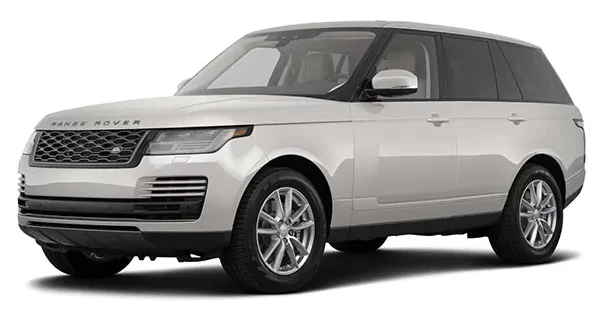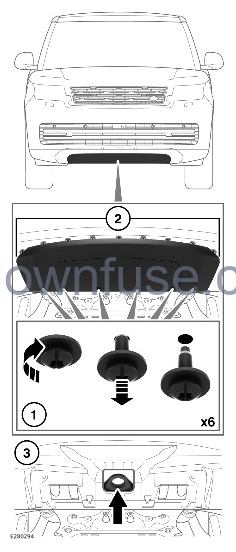2022 Land Rover New Range Rover Vehicle Recovery

RECOVERY METHOD
The recommended method for recovery or transportation of the vehicle is on a transporter or trailer designed for that purpose.
Make sure that vehicle recovery or transportation is carried out by suitably qualified personnel and that the vehicle is secured correctly.
The recovery agent must activate the transmission park release before recovery commences. The procedure is covered in a separate publication for service personnel. Failure to activate the transmission park release can result in serious transmission damage.
The vehicle should only be towed on all four wheels and must not be recovered with the front or rear wheels suspended. Doing so can result in serious transmission damage.
FRONT TOWING EYE
Use extreme caution when moving or towing the vehicle. Death or serious injury may occur.
Use extreme caution when detaching towing equipment. Vehicle movement is possible which can result in serious injury.
Remove the front towing point cover before driving off-road, to prevent damage or loss. The cover must be replaced before driving on the road.
The front towing point is located behind removable covers in the lower front bumper.

The towing eye covers are a two-part assembly. To remove the covers:
- Rotate each of the fasteners (1) counter-clockwise with a suitable tool and remove the fasteners. Keep them somewhere safe.
- Pull the front edge of the covers (2) downwards and forwards to release.
- The towing eye (3) is located in the center of the front bumper.
To refit the covers:
- Offer up the cover assembly and make sure the lugs at the top edge engage with the holes in the body panel.
- Replace each of the fasteners. Rotate each fastener clockwise with a suitable tool until tight to secure the covers in position.
REAR TOWING EYE
The towing eye at the rear of the vehicle is designed for on-road recovery only. If it is used for any other purpose, it may result in vehicle damage and serious injury.
Use extreme caution when moving or towing the vehicle. Death or serious injury may occur.
Use extreme caution when detaching towing equipment. Vehicle movement is possible, which can result in serious injury.

The rear towing eye is located behind an access panel in the rear bumper.
To use the towing eye:
- Unscrew the four trim clips and pull them outwards.
- Pull the panel outward.
- The towing eye is located in the center of the rear bumper beam.
To refit, the access panel, align the lugs into the recess in the bumper. Refit the trim clips and push the screw heads flush to secure.
OFF-ROAD RECOVERY
If the towing points are to be used for off-road recovery, it is essential that off-road driver training, covering recovery techniques is undertaken. Further information on off-road driver training can be found at: www.landroverexperience.com.
TRANSMISSION PARK RELEASE
Make sure the following warnings and cautions have been read and fully understood before carrying out the transmission park release. Failure to follow the guidance given could lead to serious injury, death, or vehicle damage.
Before attempting the transmission park release procedure, make sure that the vehicle is secured with wheel chocks and apply the Electric Parking Brake (EPB). Failure to secure the vehicle can result in unexpected movement of the vehicle, which could result in personal injury.
It is recommended that the following procedure is carried out only by qualified personnel. If in any doubt about carrying out the instructions, or if the warnings in this section cannot be complied with, seek qualified assistance. Failure to carry out the procedure as described could result in injury or death.
When Park [P] is released, the vehicle is free to move. Be sure to secure the vehicle to prevent unwanted movement. Unwanted movement of the vehicle can result in vehicle damage.
The transmission must be removed from Park (P) before recovering the vehicle. Failure to follow the transmission park release procedure can result in serious transmission damage. The transmission park release procedure locks the transmission in Neutral (N) and prevents the transmission from automatically selecting Park (P).
The following conditions must be satisfied before the transmission park release procedure will function. If any of these conditions are not met, the transmission park release procedure will not work.
- The vehicle must be stationary.
- The EPB must be applied.
- The vehicle battery must be sufficiently charged.
- The engine cranks but fails to start.
To release the park mechanism, follow this procedure:
- Apply the EPB. See ELECTRIC PARKING BRAKE (EPB).
- Press the Start button. Do not press the brake pedal when pressing the Start button at this stage.
- Press and hold the brake pedal with your left foot during the next stages of the process.
- Press and hold the accelerator fully for one second, then release it fully.
- Press and hold the accelerator fully for four seconds then release fully. Depending on vehicle specification, the instrument panel may display a message to confirm the gearbox is in service mode.
- Press the Start button to release from Park (P). The gear selector displays a flashing (P).
- The engine will attempt to start several times.
- Wait for the engine to complete the attempts to start, which can take up to 30 seconds.
- Move the gear selector to the Neutral (N) position. The instrument panel and gear selector display (N). See AUTOMATIC TRANSMISSION.
- Release the brake pedal.
The vehicle can be towed once the EPB has been released as a result of the above procedure. See ELECTRIC PARKING BRAKE (EPB).
The EPB may remain applied due to a critical system failure. Towing the vehicle with the EPB applied may result in damage to the vehicle’s tires.
If the vehicle remains stationary for longer than 10 minutes the system automatically re-engages Park ‘P’ gear to prevent battery drainage.
If the vehicle battery is not sufficiently charged the transmission park release procedure cannot be completed. The vehicle cannot be towed until the park release procedure is successfully completed.
If the engine is unable to crank, the park release procedure cannot be completed. The vehicle cannot be towed until the park release procedure is successfully completed.
TRANSPORTING THE VEHICLE
Use extreme caution when moving or towing the vehicle. Death or serious injury may occur.
The front and rear tie-down points must be used only for securing the vehicle during transportation. If they are used for any other purpose, it may result in vehicle damage and serious injury.
The recommended method for recovery/transporting the vehicle is by a trailer designed for that purpose.
Always use qualified persons to perform recovery and to make sure that the vehicle is secured correctly.
If the vehicle’s electronics are operational, the air suspension must be set to access height, before securing the vehicle to a recovery vehicle or trailer. Failure to do so can result in damage to the vehicle.
TOWING THE VEHICLE ON FOUR WHEELS
If Neutral (N) is selected and the engine is then switched off, the transmission automatically selects Park (P) after 10 minutes have elapsed. At this point, if the transmission park release mechanism has not been activated and the vehicle is being towed, serious damage to the transmission will result. There is also a danger to personal safety.
If the engine cannot be used during towing, there will be no power assistance to the braking system. The lack of power assistance results in a much greater effort to stop the vehicle and in a greatly increased stopping distance.
The recovery agent MUST activate the transmission park release mechanism before towing commences. Failure to activate the transmission park release may result in vehicle damage.
Only tow the vehicle in a forward direction with all four wheels on the ground. Towing in a reverse direction, or with only two wheels on the ground, will cause serious damage to the transmission.
Do not tow the vehicle for more than 30 miles (50 km). Do not exceed 30 mph (50 km/h). Towing for a greater distance or at a higher speed may result in serious damage to the transmission.
Do not tow the vehicle if the transmission cannot be set in Neutral (N), or if the rear electronic differential has failed in the locked position. Doing so may result in damage to the vehicle.
The vehicle should be recovered with all four wheels clear of the ground, i.e., on a trailer. If the vehicle cannot be recovered by using the correct method, in an emergency, the vehicle can be towed on all four wheels for a short distance. Please adhere to the following guidelines:
The following procedure must be carried out carefully to prevent damage to the vehicle:
- Secure the towing attachment from the recovery vehicle to the front towing eye. See FRONT TOWING EYE.
- With the Electric Parking Brake (EPB) applied, switch on the ignition. Make sure that the steering lock is unlocked.
- Apply the brake pedal and rotate the gear selector to Neutral (N).
- If Neutral cannot be selected, follow the transmission park release procedure. See TRANSMISSION PARK RELEASE.
- Leave the smart key in a secure place inside the vehicle.
- Release the EPB before towing the vehicle.
Leaving the ignition switched on for extended periods will drain the vehicle’s battery.
AFTER TOWING ON FOUR WHEELS
- Apply the Electric Parking Brake (EPB).
- Switch on the ignition and apply the brake pedal.
- Rotate the gear selector to Park (P).
- Switch off the ignition and remove the Smart key from the vehicle.
- Remove the recovery vehicle’s towing attachment from the front towing eye and refit the cover. See FRONT TOWING EYE.
Use extreme caution when detaching towing equipment. Vehicle movement is possible which can result in serious injury.

